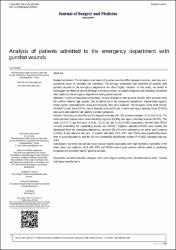| dc.contributor.author | Ertekin, Ayşe | |
| dc.date.accessioned | 2022-05-06T07:46:18Z | |
| dc.date.available | 2022-05-06T07:46:18Z | |
| dc.date.issued | 2021 | en_US |
| dc.identifier.citation | Ertekin, A. (2021). Analysis of patients admitted to the emergency department with gunshot wounds . Journal of Surgery and Medicine , 5 (5) , 482-485 . DOI: 10.28982/josam.899384 | en_US |
| dc.identifier.issn | 2602-2079 | |
| dc.identifier.uri | https://doi.org/10.28982/josam.899384 | |
| dc.identifier.uri | https://hdl.handle.net/20.500.12933/893 | |
| dc.description.abstract | Background/Aim: The incidence and nature of gunshot wounds differ between countries, and they are a prominent cause of mortality and morbidity. The primary assessment and treatment of patients with gunshot wounds in the emergency department are often highly complex. In this study, we aimed to investigate the effect of clinical findings and trauma scores on patient prognosis and mortality of patients who applied to the emergency department with gunshot wounds. Methods: In this retrospective cohort study, records of patients with gunshot wounds were accessed from the archive. Patients' age, gender, time of admission to the emergency department, injured body regions, image reports, hospitalization status and mortality rates were analyzed. The Glasgow Coma Scale (GCS), Revised Trauma Score (RTS), Injury Severity Score (ISS) and Trauma and Injury Severity Score (TRISS) rates were calculated for all patients to predict prognosis. Results: Most injuries (50.8%) and the highest mortality (66.7%) occurred between 16:01 and 24:00. The most common injuries were lower extremity injuries (63.9%) and upper extremity injuries (47.5%). The mean GCS, RTS, and ISS were 13 (3.6), 7.07 (2.23), and 12.36 (10.48), respectively, and the mean TRISS survival probability for penetrating trauma was 88.59%. Eighteen patients (29.5%) were treated and discharged from the emergency department, nineteen (31.2%) were admitted to the wards and 9 patients (14.8%), to the intensive care unit. In patients who died, GCS, RTS, and TRISS were significantly lower than in surviving patients, and the ISS was statistically significantly higher (P<0.001). Mortality rate was 9.8%. Conclusion: Gunshot wounds can cause serious injuries associated with high mortality, especially in the head, chest, and abdomen. GCS, ISS, RTS and TRISS trauma score systems will be useful in predicting prognosis and mortality rates in gunshot wounds. | en_US |
| dc.language.iso | eng | en_US |
| dc.publisher | Fatih BAŞAK | en_US |
| dc.relation.isversionof | 10.28982/josam.899384 | en_US |
| dc.rights | info:eu-repo/semantics/openAccess | en_US |
| dc.subject | Gunshot wounds | en_US |
| dc.subject | Glasgow coma scale | en_US |
| dc.subject | Injury severity score | en_US |
| dc.subject | Revised trauma score | en_US |
| dc.subject | Trauma and injury severity score | en_US |
| dc.title | Analysis of patients admitted to the emergency department with gunshot wounds | en_US |
| dc.type | article | en_US |
| dc.authorid | 0000-0002-9947-9917 | en_US |
| dc.department | AFSÜ, Tıp Fakültesi, Dahili Tıp Bilimleri Bölümü, Acil Tıp Ana Bilim Dalı | en_US |
| dc.contributor.institutionauthor | Ertekin, Ayşe | |
| dc.identifier.volume | 5 | en_US |
| dc.identifier.issue | 5 | en_US |
| dc.identifier.startpage | 482 | en_US |
| dc.identifier.endpage | 485 | en_US |
| dc.relation.journal | Journal of Surgery and Medicine | en_US |
| dc.relation.publicationcategory | Makale - Uluslararası Hakemli Dergi - Kurum Öğretim Elemanı | en_US |
















